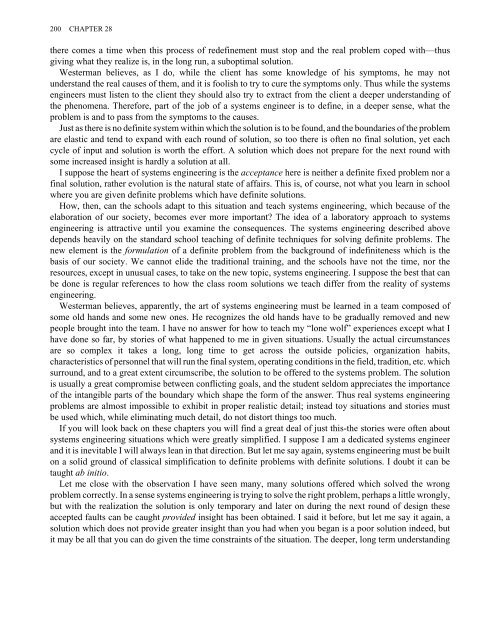hamming
hamming
hamming
You also want an ePaper? Increase the reach of your titles
YUMPU automatically turns print PDFs into web optimized ePapers that Google loves.
200 CHAPTER 28there comes a time when this process of redefinement must stop and the real problem coped with—thusgiving what they realize is, in the long run, a suboptimal solution.Westerman believes, as I do, while the client has some knowledge of his symptoms, he may notunderstand the real causes of them, and it is foolish to try to cure the symptoms only. Thus while the systemsengineers must listen to the client they should also try to extract from the client a deeper understanding ofthe phenomena. Therefore, part of the job of a systems engineer is to define, in a deeper sense, what theproblem is and to pass from the symptoms to the causes.Just as there is no definite system within which the solution is to be found, and the boundaries of the problemare elastic and tend to expand with each round of solution, so too there is often no final solution, yet eachcycle of input and solution is worth the effort. A solution which does not prepare for the next round withsome increased insight is hardly a solution at all.I suppose the heart of systems engineering is the acceptance here is neither a definite fixed problem nor afinal solution, rather evolution is the natural state of affairs. This is, of course, not what you learn in schoolwhere you are given definite problems which have definite solutions.How, then, can the schools adapt to this situation and teach systems engineering, which because of theelaboration of our society, becomes ever more important? The idea of a laboratory approach to systemsengineering is attractive until you examine the consequences. The systems engineering described abovedepends heavily on the standard school teaching of definite techniques for solving definite problems. Thenew element is the formulation of a definite problem from the background of indefiniteness which is thebasis of our society. We cannot elide the traditional training, and the schools have not the time, nor theresources, except in unusual cases, to take on the new topic, systems engineering. I suppose the best that canbe done is regular references to how the class room solutions we teach differ from the reality of systemsengineering.Westerman believes, apparently, the art of systems engineering must be learned in a team composed ofsome old hands and some new ones. He recognizes the old hands have to be gradually removed and newpeople brought into the team. I have no answer for how to teach my “lone wolf” experiences except what Ihave done so far, by stories of what happened to me in given situations. Usually the actual circumstancesare so complex it takes a long, long time to get across the outside policies, organization habits,characteristics of personnel that will run the final system, operating conditions in the field, tradition, etc. whichsurround, and to a great extent circumscribe, the solution to be offered to the systems problem. The solutionis usually a great compromise between conflicting goals, and the student seldom appreciates the importanceof the intangible parts of the boundary which shape the form of the answer. Thus real systems engineeringproblems are almost impossible to exhibit in proper realistic detail; instead toy situations and stories mustbe used which, while eliminating much detail, do not distort things too much.If you will look back on these chapters you will find a great deal of just this-the stories were often aboutsystems engineering situations which were greatly simplified. I suppose I am a dedicated systems engineerand it is inevitable I will always lean in that direction. But let me say again, systems engineering must be builton a solid ground of classical simplification to definite problems with definite solutions. I doubt it can betaught ab initio.Let me close with the observation I have seen many, many solutions offered which solved the wrongproblem correctly. In a sense systems engineering is trying to solve the right problem, perhaps a little wrongly,but with the realization the solution is only temporary and later on during the next round of design theseaccepted faults can be caught provided insight has been obtained. I said it before, but let me say it again, asolution which does not provide greater insight than you had when you began is a poor solution indeed, butit may be all that you can do given the time constraints of the situation. The deeper, long term understanding


